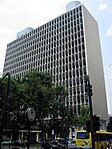March of the One Hundred Thousand
1968 in BrazilJune 1968 events in South AmericaMilitary dictatorship in BrazilUnião Nacional dos Estudantes
The March of the One Hundred Thousand (Portuguese: Passeata dos Cem Mil) was a manifestation of popular protest against the Military dictatorship in Brazil, which occurred on June 26, 1968 in Rio de Janeiro, organized by the student movement and with the participation of artists, intellectuals and other sectors of Brazilian society.
Excerpt from the Wikipedia article March of the One Hundred Thousand (License: CC BY-SA 3.0, Authors).March of the One Hundred Thousand
Avenida Rio Branco, Rio de Janeiro Centro (Zona Central do Rio de Janeiro)
Geographical coordinates (GPS) Address Phone number Website Nearby Places Show on map
Geographical coordinates (GPS)
| Latitude | Longitude |
|---|---|
| N -22.91 ° | E -43.1756 ° |
Address
Biblioteca Nacional
Avenida Rio Branco 219
20040-008 Rio de Janeiro, Centro (Zona Central do Rio de Janeiro)
Rio de Janeiro, Brazil
Open on Google Maps








